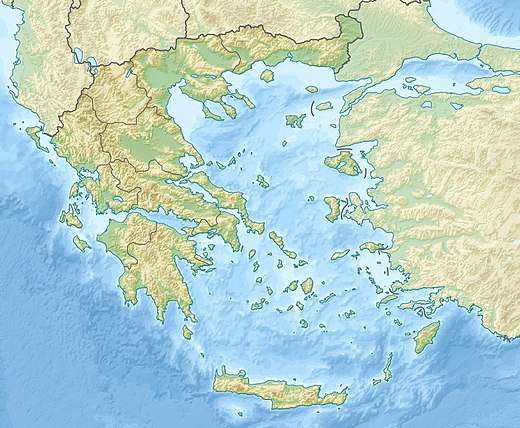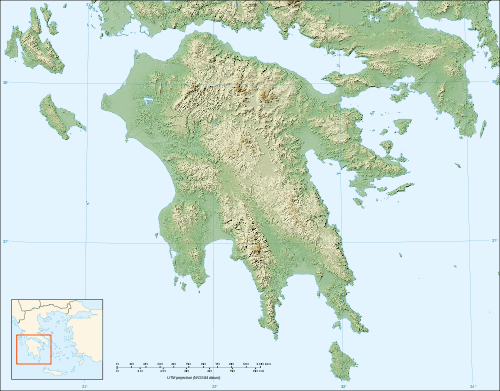Apidima Cave
The Apidima Cave (Greek: Σπήλαιο Απήδημα, Spilaio Apidima) is a complex of four small caves[2] located on the western shore of Mani Peninsula in southern Greece. A systematic investigation of the cave has yielded Neanderthal and Homo sapiens fossils from the Palaeolithic era.[3][4]
| Apidima Cave | |
|---|---|
 Location of Apidima Cave in Greece  Apidima Cave (Peloponnese) | |
| Location | On western Mani Peninsula, west of Areopoli, southern Greece |
| Coordinates | 36°39′41″N 22°21′48″E[1][1] |
| Geology | Karstic cave in the limestone cliffside |
| Entrances | 4 |
| List of entrances | A, B, C, D |
| Access | Only by boat |
| Website | www1 |
One skull fossil, given the name Apidima 1,[2] shows a mixture of modern human and primitive features[5] and has been dated to be more than 210,000 years old, older than a Neanderthal skull ("Apidima 2") found at the cave,[5] which makes Apidima 1 the oldest proof of Homo sapiens living outside Africa.[6][7] Apidima 1 is more than 150,000 years older than previous H. sapiens finds in Europe.[5]
Description
The Apidima Cave complex consists of karstic caves formed in the limestone cliffside on the west shore of the Mani Peninsula in southern Greece.[8] Today the caves open on the face of a large sea cliff and are only accessible by boat,[9] but during the ice ages the sea level went lower by more than 100 m (330 ft), and several seashore caves around the world, today submerged or situated at the wave zone—Apidima Cave belonging to the latter category—rose well above the water surface and were occupied by early people.[10]
The complex consists of four small caves, designated "A", "B", "C" and "D".[2] It was formed by erosion within the Middle Triassic to Late Eocene limestone of depth 500 m (1,600 ft), from 4–24 m (13–79 ft) above sea level, in a vertical zone of depth 20 m (66 ft).[11] The development of the caves is due to the vertical strikes of the limestone, while the horizontal opening is made by the sea.[11]
Archaeology
Research programme
The scientific research programme at Apidima began in 1978 and is being conducted by the National Archaeological Museum of Greece in collaboration with the Laboratory of Historical Geology-Palaeontology of Athens University, the Institute of Geology and Mineral Exploitation and the Aristotle University of Thessaloniki.[4]
Findings
Approximately 20,000 bones, bone fragments, and teeth from various fauna have been collected since 1978 from this site by Theodore Pitsios and his team. There are a few animal specimens with probable traces of butchering.[11] The two Homo fossils were excavated from the thick and cohesive breccia 4 m (13 ft) above sea level.[11]
Homo fossils
Researchers uncovered two significant fossils in Apidima Cave "A" in 1978. The two fossils are now referred to as Apidima 1 and Apidima 2.[5][12] Stone tools were found in all four caves.[9] Research published in July 2019 indicates that the Apidima 2 skull fragment (designated LAO 1/S2[2]) has Neanderthal morphology, and using uranium-thorium dating,[5] was found to be more than 170,000 years old.[6][13][14] The Apidima 1 skull fossil (designated LAO 1/S1[2]) was found to be older, dated—using the same method—to more than 210,000 years old, and presents a mixture of modern human and primitive features.[5] This makes Apidima 1 the oldest evidence of Homo sapiens outside Africa,[6][5][15][16] more than 150,000 years older than previous H. sapiens finds in Europe.[5][13][15][17]
The lead researcher, Katerina Harvati, summarized, "Our results suggest that at least two groups of people lived in the Middle Pleistocene in what is now southern Greece: an early Homo sapiens population, followed by a Neanderthal population."[18] Harvati said that the team would attempt to extract ancient DNA from the fossils, but that she was not optimistic about finding any.[16] If sufficient specimens can be obtained, a palaeoproteomic analysis of ancient proteins may also be done on the fossils.[3]
See also
- Early human migrations
- List of human evolution fossils
- Misliya cave
- Prehistory of Southeastern Europe
References
- Apidima Cave - location.
- Harvati, K.; Delson, E. (1999). "Conference Report: Paleoanthropology of the Mani Peninsula (Greece)". Journal of Human Evolution. 36 (3): 343–348. CiteSeerX 10.1.1.508.7565. doi:10.1006/jhev.1998.0284.
- Delson, Eric (10 July 2019). "An early dispersal of modern humans from Africa to Greece - Analysis of two fossils from a Greek cave has shed light on early hominins in Eurasia. One fossil is the earliest known specimen of Homo sapiens found outside Africa; the other is a Neanderthal who lived 40,000 years later". Nature. 571 (7766): 487–488. doi:10.1038/d41586-019-02075-9. PMID 31337897.
- Apidima Cave. Accessed on 10 July 2019.
- Katerina Harvati; Carolin Röding; Abel M. Bosman; Fotios A. Karakostis; Rainer Grün; Chris Stringer; Panagiotis Karkanas; Nicholas C. Thompson; Vassilis Koutoulidis; Lia A. Moulopoulos; Vassilis G. Gorgoulis; Mirsini Kouloukoussa (2019). "Apidima Cave fossils provide earliest evidence of Homo sapiens in Eurasia". Nature. 571 (7766): 500–504. doi:10.1038/s41586-019-1376-z. PMID 31292546.
- Earliest modern human found outside Africa. BBC News. 10 July 2019.
- Sample, Ian (10 July 2019). "Piece of skull found in Greece 'is oldest human fossil outside Africa' - Remains discovered on Mani peninsula could rewrite history of Homo sapiens in Eurasia". The Guardian. Retrieved 11 July 2019.
- Harvati, Katerina; Darlas, Andreas; Bailey, Shara E.; Rein, Thomas R.; El Zaatari, Sireen; Fiorenza, Luca; Kullmer, Ottmar; Psathi, Eleni (2013). "New Neanderthal remains from Mani peninsula, Southern Greece: The Kalamakia Middle Paleolithic cave site". Journal of Human Evolution. 64 (6): 486–499. doi:10.1016/j.jhevol.2013.02.002.
- Signals of Evolution in the Territory of Greece. Paleoanthropological Findings. Christos Valsamis. Intensive Course in Biological Anthropology. 1st Summer School of the European Anthropological Association. 16–30 June 2007, Prague, Czech Republic.
- Flemming, Nic; Antonioli, Fabrizio (2017). "Prehistoric Archaeology, Palaeontology, and Climate Change Indicators from Caves Submerged by Change of Sea Level". In Campbell, Peter B. (ed.). The Archaeology of Underwater Caves (PDF). Southampton: Highfield Press. ISBN 978-0992633677.
- Tsoukala, Evangelia (1999). "Quarternary large mammals from the Apidima Caves (Lakonia, S Peloponnese, Greece)" (PDF). Beiträge zur Paläontologie. 24: 207–229.
- Harvati, Katerina; Stringer, Chris; Karkanas, Panagiotis (2011). "Multivariate analysis and classification of the Apidima 2 cranium from Mani, Southern Greece". Journal of Human Evolution. 60 (2): 246–250. doi:10.1016/j.jhevol.2010.09.008. PMID 21122894.
- Zimmer, Carl (10 July 2019). "A Skull Bone Discovered in Greece May Alter the Story of Human Prehistory - The bone, found in a cave, is the oldest modern human fossil ever discovered in Europe. It hints that humans began leaving Africa far earlier than once thought". The New York Times. Retrieved 11 July 2019.
- Bartsiokas, Antonis; Arsuaga, Juan Luis; Aubert, Maxime; Grün, Rainer (2017). "U-series dating and classification of the Apidima 2 hominin from Mani Peninsula, Southern Greece". Journal of Human Evolution. 109: 22–29. doi:10.1016/j.jhevol.2017.04.008. PMID 28688457.
- Yong, Ed (10 July 2019). "The Story of Humans and Neanderthals in Europe Is Being Rewritten - A 210,000-year-old skull is the oldest Homo sapiens fossil found outside Africa". The Atlantic. Retrieved 10 July 2019.
- Some Apidima Skull Is Earliest Homo Sapiens Outside Africa, Say Researchers. Gemma Tarlach, Discover. July 10, 2019.
- Staff (10 July 2019). "'Oldest remains' outside Africa reset human migration clock". Phys.org. Retrieved 10 July 2019.
- de Lazaro, Enrico (11 July 2019). "Enigmatic Skull Found in Greece Suggests Early Homo sapiens Reached Europe 210,000 Years Ago". Sci-News. Retrieved 12 July 2019.